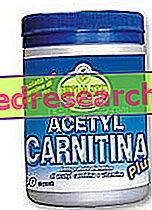Generality
Pellagra is a disease caused by the lack or non-absorption of niacin, also known as vitamin B3, nicotinic acid or vitamin PP (from English Pellagra Preventing ).
Still on the subject of acronyms, pellagra is otherwise known as a three D disease, in reference to the symptomatic trio that characterizes it: diarrhea, dermatitis and dementia. In the absence of treatment, the prognosis is poor, so that English speakers speak of 4 D disease ( dementia, dermatitis, diarrhea and death, "death")

Causes
Besides niacin deficiency, pellagra can also be caused or aggravated by a deficiency of the amino acid tryptophan.
In fact, the human body is able to transform tryptophan into nicotinic acid (60 mg of tryptophan equals 1 mg of niacin).
The predominantly maidic diet of the beginning of the last century, which saw corn polenta as the basic food of the peasant people, was one of the main culprits of pellagra, long endemic in Italy since the early decades of the eighteenth century. The maize proteins are in fact poor in tryptophan and the niacin contained in its seeds is poorly absorbable, as it is covalently linked to small peptides (niacinogens) and to glucides (niacitin).
The Maya, although they had a diet mainly based on corn, did not suffer from pellagra, since maidic niacin became available through a basic treatment (the niacin contained in the tortillas, unlike the one present in the polenta, is therefore absorbable by the body ).
In addition to poor dietary intake, pellagra can be caused by ineffective intestinal absorption; it can therefore develop as a result of defective absorption due to lesions of the digestive system, for example due to alcoholism, gastroresection or intense smoking. Rare causes of pellagra are represented by the deviation of the metabolism of tryptophan towards serotonin, due to the action of a malignant carcinoid, and by iatrogenic pharmacological factors (isoniazid, acetylpridine, thiosemicarbazone, metopterin, 5-fluorouracil, azathioprine, etc.). People with eating disorders such as anorexia nervosa are also at risk of subclinical pellagra.
Where is Vitamin PP located?
Good natural resources of vitamin PP are represented by whole grains, meat, fish, eggs, brewer's yeast, peanuts and liver. The recommended intake level is 6.6 mg / 1000 kcal, with a minimum of 19 mg / day for men and 14 mg / day for women.
Diagnosis
The diagnosis of pellagra, as well as the recognition of symptoms and cutaneous manifestations, is confirmed by low urinary levels of the specific metabolites of niacin.
Symptoms
To learn more: Pellagra Symptoms
Scaly skin (dermatitis), diarrhea, mental confusion, insomnia, nervousness, psychic slowing, apathy, depression, dementia, delirium, inflammation of the mucous membranes, dry and chapped lips with obvious fissures at the corners of the mouth, anal fissures, fissures of the nostrils, stomatitis, gingivitis, severe and showy glossitis and achlorhydria - istamino-resistant hypochloridria.
To this symptomatological set we must add the lack of appetite (anorexia, addressed above all to meat foods), asthenia, anemia, hypotension, hypoproteinemia and vomiting.
Pellagra skin lesions are the result of abnormal skin sensitization to sunlight; they tend to appear symmetrically on the areas exposed to the sun - such as arms, legs, face, neck and upper chest - by stopping abruptly at the points where the skin is covered by clothing. Initially similar to burns, they then tend to become reddish, tending to brown, rough and scaly, similar to roasted meat, of which they also smell.
In the larger forms, in the absence of treatment, the prognosis is poor; the course is chronic, with spontaneous regressions in autumn and winter, and exacerbations in the early spring suns; these become more and more serious, to the point of causing so-called pellagrid dementia, as well as a profound cachectic state.
Treatment and therapy of pellagra
In humans, pellagra is rarely caused by the simple deficiency of niacin, as evidenced by the poor response to treatment with nicotinamide (derivative of nicotinic acid); better results are obtained by combined administration of multivitamins (B vitamins, such as B1, B2, B3, B6 and B12) and a high-protein diet. Complete the specific therapeutic intervention for pellagra, corrections of the causes of malabsorption, protection from sunlight and topical application of antibacterial, lenitive, antifungal and photoprotective medications.



